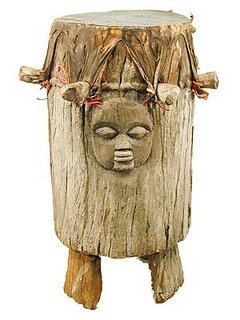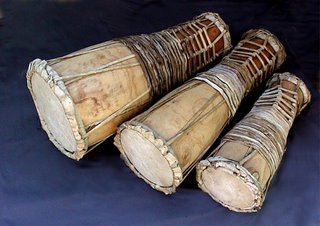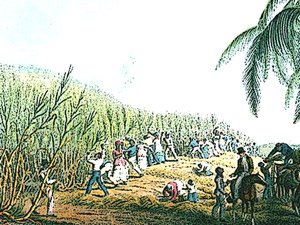
In 1511, several indigenous Taino Caciques in Puerto Rico allied with the Caribs and tried to oust the Spaniards. The revolt was pacified by the forces of Governor Juan Ponce de Leon.
It is written that after the native revolt was surpressed some Tainos fled the island and others jumped into the sea rather than be enslaved by Spaniards. The Tainos who remained on the island were decimated by European diseases.
A new labor force would be needed to satisfy the voracious appetites of the Spanish. In 1517, the Spanish Crown permitted its subjects to import twelve slaves each in what became the beginning of the slave trade in the New World.
The Spaniards coined the term 'Bozales' for those brought to the New World straight from Africa. They consisted of Africans from different regions and ethnic groups. This was done to prevent them from communicating with each other and planning an uprising or revolt.
The first enslaved Africans to arrive on the island of Puerto Rico in any sizable numbers were from Senegal. The next group were the Mandingo from the Western Sudan.
Despite the Spaniard's precautions,they could not stop the enslaved Africans from mounting the first recorded rebellion in Latin America (July 26-Nov 23, 1514). King Ferdinand of Spain then authorized Seville to import Africans only in groups of 50 (up to 200), so they could be more easily controlled.
Later arrivals to the island were from the Guinea area. People who were preferred for their perceived quality of; "not being war-like". After the slave revolt of 1527, Spanish edicts were passed prohibiting the importation of Africans from Islamic areas since; "they do not make good slaves and they are prone to revolt".
According to historian Luis M. Diaz, the largest contingent of Africans came from the Gold Coast, Nigeria and Dahomey, or the region known as the area of Guineas, the Slave Coast. However, the vast majority came from the Yorubas tribe from Nigeria and the Bantus from the Guineas. The number of slaves in Puerto Rico rose from 1,500 in 1530 to 15,000 by 1555. The slaves were branded on the forehead with a stamp so people would know they were brought in legally and that way they couldn't be kidnapped. The cruelty of hot branding was stopped in 1784.
The African slave was sent to work the gold mines, as a replacement of the lost Taino manpower, or to work in the fields in the islands ginger and sugar industry. By 1570, the gold mines were declared depleted and no longer produced the precious metal. After gold mining came to an end in the island, the Spanish Crown basically ignored Puerto Rico by changing the routes of the west to the north. The vast majority of the white Spanish settlers left the island to seek their fortunes in the richer colonies such as Mexico and the island became a Spanish garrison. The majority of those who stayed behind were either Bozales or Creoles (of mixed race).
An official Spanish edict of 1664 offered freedom and land to African people from non-Spanish colonies, such as Jamaica and St. Dominique (Haiti), who immigrated to Puerto Rico and provided a population base to support the Puerto Rican garrison and its forts.
These freeman who settled the western and southern parts of the island, soon adopted the ways and customs of the Spaniards. Some joined the local militia which fought against the British in their many attempts to invade the island. It should be noted that the escaped slaves and freedman who immigrated from the West Indies, kept their former masters surnames which normally was either English or French. This is why it is not uncommon for Puerto Ricans of African decedent to have non-Spanish surnames.
After the successful slave rebellion against the French in St Dominique (Haiti) in 1803, the Spanish Crown became fearful that the "Criollos" (native born) of Puerto Rico and Cuba, her last two remaining possessions, may follow suit. By the time Spain reestablished her commercial ties with Puerto Rico, the island had a large multiracial population. Therefore, the Spanish government issued the Royal Decree of Graces of 1815, attracting European immigrants from non-Spanish countries to populate the island believing that these new immigrants would be more loyal to Spain. However, they did not expect the new immigrants to racially intermarry as they did and identify themselves completely with their new homeland. The decree encouraged slave labor to revive agriculture and attract new settlers. The new agricultural class now immigrating from other countries of Europe sought slave labor in large numbers and cruelty became the order of the day.
The Spanish government had lost most of its possessions in the New World by 1850. The Spanish government in fear of an independence or slavery revolt imposed draconian laws, "El Bando contra La Raza Africana", to control the behavior of all Black Puerto Ricans, slave or free. It is for this reason that we see a series of slave uprisings in the island, from the early 1820's until 1868.
Even though one of the reasons that the Spanish Crown put the Royal Decree of Graces of 1815 into effect was to "whiten" the islands population by offering attractive incentives to non-Hispanic Europeans, the new arrivals continued to intermarry with the native islanders. By 1868, the majority of the population of Puerto Rico was interracially mixed.
On September 23, 1868, slaves, who were promised their freedom, participated in the short failed revolt against Spain which became known in the history books as "El Grito de Lares" or "The Cry of Lares". Many of the participants were imprisoned or executed.
Finally, on March 22, 1873, slavery was abolished in Puerto Rico. Slave owners were to free their slaves in exchange of a monetary compensation. The majority of the freed slaves continued to work for their former masters with the difference that they were now 'freeman'.
Many of these freeman started settlements in the areas which became known as Cangrejos (Santurce), Carolina, Canovanas, Loíza Aldea and Luquillo.
 The African was not alone in recognizing the spirit of life that surrounded him.
The African was not alone in recognizing the spirit of life that surrounded him.























